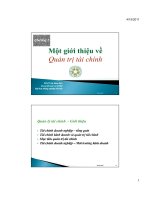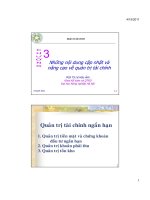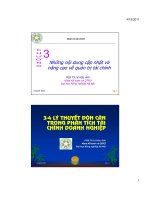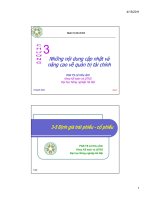ĐÁP ÁN SÁCH QUẢN TRỊ TÀI CHÍNH CUỐN TO DÀY uel KINH TE LUAT 2
Bạn đang xem bản rút gọn của tài liệu. Xem và tải ngay bản đầy đủ của tài liệu tại đây (103.6 KB, 11 trang )
Learning Objectives
Chapter 3
Financial Statements, Cash Flow, and Taxes
After reading this chapter, students should be able to:
Briefly explain the history of accounting and financial statements, and how financial
statements are used.
List the types of information found in a corporation’s annual report.
Explain what a balance sheet is, the information it provides, and how assets and claims
on assets are arranged on a balance sheet.
Explain what an income statement is and the information it provides.
Differentiate between net cash flow and accounting profit.
Identify the purpose of the statement of cash flows, list the factors affecting a firm’s cash
position that are reflected in this statement, and identify the three categories of activities
that are separated out in this statement.
Specify the changes reported in a firm’s statement of retained earnings.
Discuss what questions can be answered by looking through the financial statements,
and explain why investors need to be cautious when they review financial statements.
Discuss how certain modifications to the accounting data are needed and used for
corporate decision making and stock valuation purposes. In the process, explain the
terms: net operating working capital, total operating capital, NOPAT, operating cash
flow, and free cash flow; and explain how each is calculated.
Define the terms Market Value Added (MVA) and Economic Value Added (EVA),
explain how each is calculated, and differentiate between them.
Explain why financial managers must be concerned with taxation, and list some of the
most important elements of the current tax law, such as the differences between the
treatment of dividends and interest paid and interest and dividend income received.
Chapter 3: Financial Statements, Cash Flow, and Taxes
Learning Objectives
49
Lecture Suggestions
The goal of financial management is to take actions that will maximize the value of a firm’s
stock. These actions will show up, eventually, in the financial statements, so a general
understanding of financial statements is critically important.
Note that Chapter 3 provides a bridge between accounting, which students have just
covered, and financial management. Unfortunately, many non-accounting students did not
learn as much as they should have in their accounting courses, so we find it necessary to
spend more time on financial statements than we would like. Also, at Florida and many
other schools, students vary greatly in their knowledge of accounting, with accounting
majors being well-grounded because they have had more intense introductory courses and,
more importantly, because they are taking advanced financial accounting concurrently with
finance. This gives the accountants a major, and somewhat unfair, advantage over the others
in dealing with Chapters 3 and 4 on exams. We know of no good solution to this problem,
but what we do is pitch the coverage of this material to the non-accountants. If we pitch the
lectures (and exams) to the accountants, they simply blow away and demoralize our nonaccountants, and we do not want that. Perhaps Florida has more of a difference between
accounting and non-accounting students, but at least for us there really is a major difference.
What we cover, and the way we cover it, can be seen by scanning the slides and
Integrated Case solution for Chapter 3, which appears at the end of this chapter solution.
For other suggestions about the lecture, please see the “Lecture Suggestions” in Chapter 2,
where we describe how we conduct our classes.
DAYS ON CHAPTER: 2 OF 58 DAYS (50-minute periods)
50
Lecture Suggestions
Chapter 3: Financial Statements, Cash Flow, and Taxes
Answers to End-of-Chapter Questions
3-1
3-2
3-3
3-4
3-5
3-6
The four financial statements contained in most annual reports are the balance sheet,
income statement, statement of retained earnings, and statement of cash flows.
Accountants translate physical quantities into numbers when they construct the
financial statements. The numbers shown on balance sheets generally represent
historical costs. When examining a set of financial statements, one should keep in
mind the physical reality that lies behind the numbers, and the fact that the translation
from physical assets to numbers is far from precise.
Bankers and investors use financial statements to make intelligent decisions about
what firms to extend credit or invest in, managers need financial statements to
operate their businesses efficiently, and taxing authorities need them to assess taxes
in a reasonable way.
No, because the $20 million of retained earnings would probably not be held as cash.
The retained earnings figure represents the reinvestment of earnings by the firm.
Consequently, the $20 million would be an investment in all of the firm’s assets.
The balance sheet shows the firm’s financial position on a specific date, for example,
December 31, 2005. It shows each account balance at that particular point in time.
For example, the cash account shown on the balance sheet would represent the cash
the firm has on hand and in the bank on December 31, 2005. The income statement,
on the other hand, reports on the firm’s operations over a period of time, for example,
over the last 12 months. It reports revenues and expenses that the firm has incurred
over that particular time period. For example, the sales figures reported on the
income statement for the period ending December 31, 2005, would represent the
firm’s sales over the period from January 1, 2005, through December 31, 2005, not
just sales for December 31, 2005.
Investors need to be cautious when they review financial statements. While
companies are required to follow GAAP, managers still have quite a lot of discretion
in deciding how and when to report certain transactions. Consequently, two firms in
exactly the same operating situation may report financial statements that convey
different impressions about their financial strength. Some variations may stem from
legitimate differences of opinion about the correct way to record transactions. In
other cases, managers may choose to report numbers in a way that helps them present
either higher earnings or more stable earnings over time. As long as they follow
GAAP, such actions are not illegal, but these differences make it harder for investors
to compare companies and gauge their true performances.
Unfortunately, there have also been cases where managers overstepped the
bounds and reported fraudulent statements. Indeed, a number of high-profile
executives have faced criminal charges because of their misleading accounting
practices.
Chapter 3: Financial Statements, Cash Flow, and Taxes
Integrated Case
51
3-7
The emphasis in accounting is on the determination of accounting income, or net
income, while the emphasis in finance is on net cash flow. Net cash flow is the
actual net cash that a firm generates during some specified period. The value of an
asset (or firm) is determined by the cash flows generated. Cash is necessary to
purchase assets to continue operations and to pay dividends. Thus, financial
managers should strive to maximize cash flows available to investors over the long
run.
Although companies with relatively high accounting profits generally have a
relatively high cash flow, the relationship is not precise. A business’s net cash flow
generally differs from net income because some of the expenses and revenues listed
on the income statement are not paid out or received in cash during the year.
Most other companies have little if any noncash revenues, but this item can be
important for construction companies that work on multi-year projects, report income
on a percentage of completion basis, and then are paid only after the project is
completed. Also, if a company has a substantial amount of deferred taxes, which
means that taxes actually paid are less than that reported in the income statement,
then this amount could also be added to net income when estimating the net cash
flow. The relationship between net cash flow and net income can be expressed as:
Net cash flow = Net income + Non-cash charges – Non-cash revenues.
3-8
The primary examples of non-cash charges are depreciation and amortization.
These items reduce net income but are not paid out in cash, so we add them back to
net income when calculating net cash flow. Likewise, some revenues may not be
collected in cash during the year, and these items must be subtracted from net income
when calculating net cash flow. Typically, depreciation and amortization represent
the largest non-cash items, and in many cases the other non-cash items roughly net to
zero. For this reason, many analysts assume that net cash flow equals net income
plus depreciation and amortization.
Operating cash flow arises from normal, ongoing operations, whereas net cash flow
reflects both operating and financing decisions. Thus, operating cash flow is defined
as the difference between sales revenues and operating expenses paid, after taxes on
operating income. Operating cash flow can be calculated as follows:
Operating cash flow = EBIT (1 – T) + Depreciation and amortization
= NOPAT + Depreciation and amortization.
Note that net cash flow can be calculated as follows:
Net cash flow = Net income + Depreciation and amortization.
3-9
52
Thus, the difference between the two equations is that net cash flow includes aftertax interest expense.
NOPAT is the profit a company would generate if it had no debt and held only
operating assets. Net income is the profit available to common stockholders; thus,
both interest and taxes have been deducted. NOPAT is a better measure of the
Integrated Case
Chapter 3: Financial Statements, Cash Flow, and Taxes
performance of a company’s operations than net income because debt lowers income.
In order to get a true reflection of a company’s operating performance, one would
want to take out debt to get a clearer picture of the situation.
3-10 Free cash flow is the cash flow actually available for distribution to investors after
the company has made all the investments in fixed assets, new products, and
operating working capital necessary to sustain ongoing operations. It is defined as net
operating profit after taxes (NOPAT) minus the amount of net investment in
operating working capital and fixed assets necessary to sustain the business. It is the
most important measure of cash flows because it shows the exact amount available to
all investors (stockholders and debtholders). The value of a company’s operations
depends on expected future free cash flows. Therefore, managers make their
companies more valuable by increasing their free cash flow. Net income, on the
other hand, reflects accounting profit but not cash flow. Therefore, investors ought to
focus on cash flow rather than accounting profit.
3-11 Yes. Negative free cash flow is not necessarily bad. It depends on why the free cash
flow was negative. If free cash flow was negative because NOPAT was negative,
this is definitely bad, and it suggests that the company is experiencing operating
problems. However, many high-growth companies have positive NOPAT but
negative free cash flow because they must invest heavily in operating assets to
support rapid growth. There is nothing wrong with a negative cash flow if it results
from profitable growth.
3-12 Double taxation refers to the fact that corporate income is subject to an income tax,
and then stockholders are subject to a further personal tax on dividends received.
Income could even be subject to triple taxation; therefore, corporations that receive
dividend income can exclude some of the dividends from its taxable income. This
provision in the Tax Code minimizes the amount of triple taxation that would
otherwise occur.
3-13 Because interest paid is tax deductible but dividend payments are not, the after-tax
cost of debt is lower than the after-tax cost of equity. This encourages the use of debt
rather than equity. This point is discussed in detail in later chapters: “The Cost of
Capital” and “Capital Structure and Leverage.”
Chapter 3: Financial Statements, Cash Flow, and Taxes
Integrated Case
53
Solutions to End-of-Chapter Problems
3-1
NI = $3,000,000; EBIT = $6,000,000; T = 40%; Interest = ?
Need to set up an income statement and work from the bottom up.
EBIT
Interest
EBT
Taxes (40%)
NI
$6,000,000
1,000,000
$5,000,000
2,000,000
$3,000,000
$3,000,000 $3,000,000
=
0.6
EBT = (1 − T)
Interest = EBIT – EBT = $6,000,000 – $5,000,000 = $1,000,000.
3-2
EBITDA = $7,500,000; NI = $1,800,000; Int = $2,000,000; T = 40%; DA = ?
EBITDA
DA
EBIT
Int
EBT
Taxes (40%)
NI
$7,500,000
2,500,000
$5,000,000
2,000,000
$3,000,000
1,200,000
$1,800,000
EBITDA – DA = EBIT; DA = EBITDA – EBIT
EBIT = EBT + Int = $3,000,000 + $2,000,000
(Given) $1,800,000 = $1,800,000
(1 − T)
0.6
(Given)
3-3
NI = $3,100,000; DEP = $500,000; AMORT = 0; NCF = ?
NCF = NI + DEP and AMORT = $3,100,000 + $500,000 = $3,600,000.
3-4
NI = $50,000,000; R/EY/E = $810,000,000; R/EB/Y = $780,000,000; Dividends = ?
R/EB/Y + NI – Div = R/EY/E
$780,000,000 + $50,000,000 – Div = $810,000,000
$830,000,000 – Div = $810,000,000
$20,000,000 = Div.
3-5
54
Statements b and d will decrease the amount of cash on a company’s balance sheet.
Statement a will increase cash through the sale of common stock. This is a source of
cash through financing activities. On one hand, Statement c would decrease cash;
however, it is also possible that Statement c would increase cash, if the firm receives
a tax refund.
Integrated Case
Chapter 3: Financial Statements, Cash Flow, and Taxes
3-6 Ending R/E = Beg. R/E + Net income − Dividends
$278,900,000 = $212,300,000 + Net income − $22,500,000
$278,900,000 = $189,800,000 + Net income
Net income = $89,100,000.
3-7
a. From the statement of cash flows the change in cash must equal cash flow from
operating activities plus long-term investing activities plus financing activities.
First, we must identify the change in cash as follows:
Cash at the end of the year
$25,000
– Cash at the beginning of the year
– 55,000
Change in cash
-$30,000
The sum of cash flows generated from operations, investment, and financing must
equal a negative $30,000. Therefore, we can calculate the cash flow from
operations as follows:
CF from operations + CF from investing + CF from financing
= ∆ in cash
CF from operations − $250,000 + $170,000 = -$30,000
CF from operations = $50,000.
b. To determine the firm’s net income for the current year, you must realize that cash
flow from operations is determined by adding sources of cash (such as
depreciation and amortization and increases in accrued liabilities) and subtracting
uses of cash (such as increases in accounts receivable and inventories) from net
income. Since we determined that the firm’s cash flow from operations totaled
$50,000 in part a of this problem, we can now calculate the firm’s net income as
follows:
NI +
Depreciati
on
and amortizati
on
+
Increasein
accrued
liabilitie
s
−
Increasein
A/R and
inventory
=
CF from
operations
NI + $10,000 + $25,000 – $100,000
NI – $65,000
NI
3-8
= $50,000
= $50,000
= $115,000.
EBIT = $750,000; DEP = $200,000; AMORT = 0; 100% Equity; T = 40%; NI = ?;
NCF = ?; OCF = ?
First, determine net income by setting up an income statement:
EBIT
Interest
EBT
$750,000
0
$750,000
Chapter 3: Financial Statements, Cash Flow, and Taxes
Integrated Case
55
Taxes (40%)
NI
300,000
$450,000
NCF = NI + DEP and AMORT = $450,000 + $200,000 = $650,000.
OCF = EBIT(1 – T) + DEP and AMORT = $750,000(0.6) + $200,000 = $650,000.
Note that NCF = OCF because the firm is 100% equity financed.
3-9
MVA = (P0 × Number of common shares) − BV of equity
$130,000,000 = $60X − $500,000,000
$630,000,000 = $60X
X = 10,500,000 common shares.
3-10 a. NOPAT = EBIT(1 – T)
= $4,000,000,000(0.6)
= $2,400,000,000.
b. NCF
= NI + DEP and AMORT
= $1,500,000,000 + $3,000,000,000
= $4,500,000,000.
c. OCF
= NOPAT + DEP and AMORT
= $2,400,000,000 + $3,000,000,000
= $5,400,000,000.
d. FCF
= NOPAT – Net Investment in Operating Capital
= $2,400,000,000 – $1,300,000,000
= $1,100,000,000.
3-11
Working up the income statement you can calculate the new sales level would be
$12,681,482.
Sales
Operating costs (excl. D&A)
EBITDA
Depr. & amort.
EBIT
Interest
56
Integrated Case
$12,681,482
6,974,815
$ 5,706,667
880,000
$ 4,826,667
660,000
$5,706,667/(1 − 0.55)
$12,681,482 × 0.55
$4,826,667 + $880,000
$800,000 × 1.10
$4,166,667 + $660,000
$600,000 × 1.10
Chapter 3: Financial Statements, Cash Flow, and Taxes
EBT
Taxes (40%)
Net income
$ 4,166,667
1,666,667
$ 2,500,000
$2,500,000/(1 − 0.4)
$4,166,667 × 0.40
3-12 a. Because we’re interested in net cash flow available to common stockholders, we
exclude common dividends paid.
amortization
CF05
= NI available to common stockholders + Depreciation and
= $372 + $220 = $592 million.
The net cash flow number is larger than net income by the current year’s
depreciation and amortization expense, which is a noncash charge.
b. Balance of RE, December 31, 2004
$1,374
Add: NI, 2005
372
Less: Div. paid to common stockholders (146)
Balance of RE, December 31, 2005
$1,600
The RE balance on December 31, 2005 is $1,600 million.
c. $1,600 million.
d. Cash + Equivalents = $15 million.
e. Total current liabilities = $620 million.
3-13 a. NOPAT05 = EBIT(1 – T)
= $150,000,000(0.6)
= $90,000,000.
b.
Net operating
workingcapital04
= Current assets –
Non-interestcharging
currentliabilitie
s
= $360,000,000 – ($90,000,000 + $60,000,000)
= $210,000,000.
Net operating
workingcapital05
= $372,000,000 – $180,000,000 = $192,000,000.
Chapter 3: Financial Statements, Cash Flow, and Taxes
Integrated Case
57
c. Operating capital04
=
Netplant
Net operating
+
andequipment workingcapital
= $250,000,000 + $210,000,000
= $460,000,000.
Operating capital05
= $300,000,000 + $192,000,000
= $492,000,000.
d. FCF05
= NOPAT – Net investment in operating capital
= $90,000,000 – ($492,000,000 – $460,000,000)
= $58,000,000.
e. The large increase in dividends for 2005 can most likely be attributed to a large
increase in free cash flow from 2004 to 2005, since FCF represents the amount of
cash available to be paid out to stockholders after the company has made all
investments in fixed assets, new products, and operating working capital
necessary to sustain the business.
3-14 a. Sales revenues
$12,000,000
Costs except deprec. and amort. (75%) 9,000,000
EBITDA
$ 3,000,000
Depreciation and amortization
1,500,000
EBT $ 1,500,000
Taxes (40%)
600,000
Net income
$ 900,000
Add back deprec. and amort.
1,500,000
Net cash flow
$ 2,400,000
b. If depreciation and amortization doubled, taxable income would fall to zero and
taxes would be zero. Thus, net income would decrease to zero, but net cash flow
would rise to $3,000,000. Menendez would save $600,000 in taxes, thus
increasing its cash flow:
∆CF = T(∆Depreciation and amortization) = 0.4($1,500,000) = $600,000.
c. If depreciation and amortization were halved, taxable income would rise to
$2,250,000 and taxes to $900,000. Therefore, net income would rise to
$1,350,000, but net cash flow would fall to $2,100,000.
d. You should prefer to have higher depreciation and amortization charges and
higher cash flows. Net cash flows are the funds that are available to the owners
58
Integrated Case
Chapter 3: Financial Statements, Cash Flow, and Taxes
to withdraw from the firm and, therefore, cash flows should be more important to
them than net income.
e. In the situation where depreciation and amortization doubled, net income fell by
100%. Since many of the measures banks and investors use to appraise a firm’s
performance depend on net income, a decline in net income could certainly hurt
both the firm’s stock price and its ability to borrow. For example, earnings per
share is a common number looked at by banks and investors, and it would have
declined by 100%, even though the firm’s ability to pay dividends and to repay
loans would have improved.
Chapter 3: Financial Statements, Cash Flow, and Taxes
Integrated Case
59









